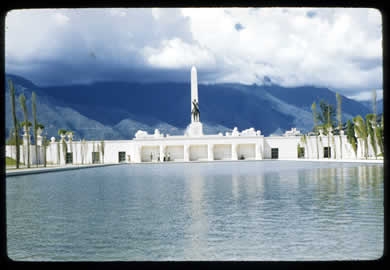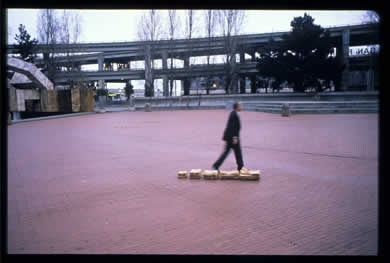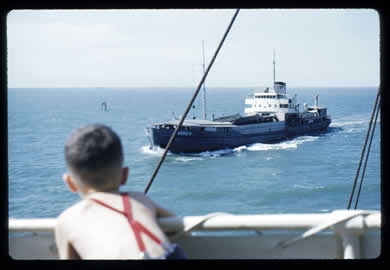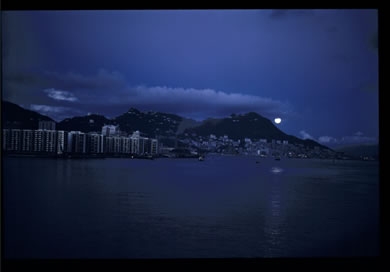Feature: Essays
Lebensraum
Area Measures
A service rep sitting in a call center in Texas put me on hold after I’d explained my problem. About 40 seconds later my call was picked up – not transferred but just taken off hold – by a service rep sitting in a call center in Minnesota. Of course I had to re-explain my problem, because he couldn’t transfer me back to the Texas rep.
In this landscape, no individual holds authority for long, because individual acts are ephemeral.
Postcard
The areas where we can reach nature are severely limited by privatization.
From 1957-1960 we lived in Caracas, Venezuela in a house stuck onto the side of a cliff. The front door was “large enough to drive a car through” and the booze flowed freely enough that soon someone did in fact drive one all the way into the living room. Seen from our balcony, the modernist white marble and stucco city gleamed as it nestled at the base of verdant green mountains rising to the sparkling blue ozone-rich sky.
My mom’s claustrophobic and won’t ride in a subway, an elevator or an airplane, so we always traveled to foreign postings aboard the small passenger liners and passenger-carrying freighters that were then ubiquitous. My first views of cities such as Tokyo, Hong Kong, Singapore, Naples and New York were from the sea, not the air.
Years later, while examining slides my parents had shot from 1956-1969, I was struck by how much green and blue there was within each of these images. In each landscape and cityscape, shot dead-on straight ahead eye-level as a tourist would, typically eighty percent of the frame was filled with ocean, sky, jungle, forest. Cities were distinct places situated within larger landscapes. Even a hyper-urbanized city such as Hong Kong was heavily framed by the dark green of hills and the grey-brown of water. It’s easy to see this same effect in postcards of places like Puerto Vallarta or Ibiza from the 1950’s – or in old National Geographic magazines. Even in photos of the largest cities (São Paolo, Tokyo, Ciudad de Mexico) the colors of the planet are very much in evidence.
Now it’s much harder to find that evidence, those colors. Rows upon rows of four-story "colonial"-style townhouses unroll like carpeting over former pastures in Northern Virginia. The brick, tin-roofed, cupola’d, turreted, bay-windowed buildings of downtown Chicago Heights, Illinois are boarded up with plywood while stands of poplars bordering U.S. Highway 30 two miles away are bulldozed to make room for construction of new town-homes for people commuting to downtown Chicago, twenty miles to the north.
The nearly seven billion of us are filling our planet, our visual field, up right to the edges; we are filling up our natural habitats and domesticating ourselves. Like other animals in captivity, we live in a schizophrenic space wedged between the often contradictory dictates of our genetically-insinuated behavioral predispositions and the survival behaviors required by our constantly- and suddenly-changing environments.
The Opera Box
A new four-story building is being built on 22nd Street near Guerrero, on the edge of San Francisco’s culturally diverse but rapidly gentrifying Mission district. It will, even after the paint job and other finishing touches, stand out from its Victorian-era neighbors because of its height and its plain modern façade, which is uninteresting to look at and includes very large windows, evidence that the design criteria of contemporary construction of this scale (predominantly residential or live/work) favor the interior (private) view over the exterior (public) view.
There are certainly many blatantly inappropriate construction projects and regulation policies being forced through San Francisco’s weak body politic, but in the main there are compelling and inexorable arguments for increasing the density of housing and commercial structures along San Francisco’s transportation corridors.
One component of local art world zeitgeist has long been the assertion that San Francisco is a "world-class" city in regard to the arts, an assertion continually deflated by the relative lack of density of infrastructural populations: audiences, critics, publishers, collectors. Density (and economic booms) are some of the factors which create "world-class" cities, and forced displacement of populations and slash and burn construction are both often part of the densifying process (cf. Robert Moses’ bypass surgery on the arteries of New York, and Baron Haussmann’s imperialization of Paris).
Is it ironic then that artists are being evicted as the city begins this evolution? Lots of people are being evicted, but artists have a stronger intentional relation to their own expressiveness and mythos and so tend to make more noise sooner than some other displaced populations.
Large cities such as New York and Paris are very dense architecturally but their density is generous: a majority of structures, even the roughest, offer up interesting surface textures and angles to the eyes of pedestrian passers-by. Many of these buildings look much better from the outside than they do from the inside. Aesthetics are of utmost importance to a city like Paris, whose power is primarily evocative rather than economic or social. In the years during which the large cities’ personalities were developed, the dramas of urbanity were played out on sidewalks, stoops and cobblestones in front of theatrical backdrops of brownstones, cornices, fire escapes and mansard roofs.
New live-work buildings are anonymous, homogeneous, offer few concessions to the view from "public" space (the street). Built to be looked out from, they are the equivalent of luxury suites at ball games: a curious mix of privacy and ostentation, like old opera boxes replete with beds for assignations during performances. There are curtains for privacy, but everyone knows you’re in there. They are podiums suitable for narcissistic conspicuous display as well as perches for voyeurs, offering privileged visual perspectives and reversing the view. Now, the primary vantage is from a small bed-loft, itself also hovering like an opera box over the stage-like living room below, where Pottery Barn catalogue scenes are being played out in front of twenty-foot-high windows. Glimpsed through these windows’ transparent grids, the cityscape becomes a filmic background in front of which Gary Cooper and Patricia Neal, wearing chinos and polo shirts, earnestly embrace. Young, economically virile, they copulate on a floating bed-loft being raised as if by tractor-beam up into a UFO.
But does this positioning of architects (and others) as Others serve merely to re-populate the city with ideological enemies?
And is it really envy? Many of these new spaces only superficially reference these symbolic points: floating bed, big windows, high ceilings. Take a look at the floor-level lofts being built at the corner of 17th and Bryant. Newly-constructed “live-work” lofts, which promise the allure and practicality of a large open plan area, are becoming as small and inflexible as any tiny one-bedroom Victorian railroad flat.
Eminent Domain
Traditional Indonesian houses’ steeply-raked roofs fend off monsoon downpours and repulse bad luck. Unable to sit on such a sharp peak, animist demons and their attendant misfortunes would slide off harmlessly. Because of the equatorial temperatures and 100% humidity, there were no two-story houses in Djakarta. The Arkansan U.S. Air Force colonel who built the house we were renting had planned a two-story design but had only managed to get the concrete pad for the second floor poured before he’d been posted elsewhere; that pad was, in 1960, the roof of the only flat-roofed single-family residence in Indonesia.
When our “houseboy” Assim announced one day that there was a family living on the roof, the word “family"had a pretty precise definition for me (at the age of five) and I pictured a mom, a dad and one child acting out a relaxed, if austere, version of a domesticity not too different from our own. I was surprised and very excited when Assim, my dad and I climbed up to the roof and discovered about a dozen adults and as many children, two cooking fires, clothes drying on low lines and a half-dozen tents and lean-tos clustered in the middle of the wide expanse of concrete, out of any line of site from the ground below.
My fantasies at that time revolved around Ivanhoe, Prince Valiant and Captain Blood. This semi-nomadic set-up would be the perfect place for me to act out all my many Errol Flynn impulses. So I was personally devastated when my father insisted that all these people had to leave the roof. I was also confused in what I suppose ought to be called a political way; I simply had no clue as to why we had to make these people leave. To my naive eyes, any potential negative impact for us (of letting them live on our roof) didn’t seem to anywhere near approach balancing out the negative impact for them (of having to leave a safe, if even barely adequate, home.) This was the first time I realized that my father and I had very different ways of looking at the world, the first time I was disappointed in a decision he made as a representative of our family in the outside world.
Our neighbor to the rear was Usmar Ismail, an important film producer and director who enjoyed screening classic western films for his friends in his backyard. After the roof had been cleared, my family and our servants joined in the neighborhood habit of roof-picnicking while watching these screenings. As we had the best vantage on Ismail’s backyard, our Indonesian neighbors from across the street would often join us. I vaguely remember seeing a D.W. Griffith film in which lots of people were crowded off a high stone wall, falling forty feet into the turbulent waters of the harbor.
The Hacienda
Your dreams spring from the reality around you and return to it in the evening, having changed everything around you.
In 1990 I was commissioned by Intersection for the Arts to do a 16-hour performance / installation using the entire space of Justin Hermann Plaza, the large ceremonial intersection of Market Street with the Embarcadero which also serves as the eastern entranceway to the Hyatt Regency Hotel and the Embarcadero [shopping] Center. A statue in the plaza commemorates the claiming of this region for the Spanish monarchy.
One of the underlying and translucent conceits of this project, The Infant Carlos III Dreams of the New World, was that I would re-enact various processes of the original colonization: separation, travel, exploration and mapping of the “discovered” site, acquisition, construction, domestication, trade and, eventually, symbolic recapitulation (i.e. creation of culture). I intended to include such actions as moving material around, building a wooden tent-like structure and burning meat on a grill so as to produce smoke and stink.
Touted as a "public" space, the plaza actually fell within two separate but overlapping jurisdictions from which I needed approvals and permissions. The Embarcadero Center Management Corporation needed only my verbal assurances that I wouldn’t impede traffic or permanently alter any physical structure. The San Francisco Park & Recreation Department, however, reviewed my proposal and balked at the shelter-building and cooking, as both were overtly against the plaza’s rules. The pleasant grassy peripheries of the plaza attracted a sizeable population of urban nomads (read: "homeless") which Park & Rec tried to dissuade by aggressively enforcing the no cooking / no shelter-building rules and thus they wouldn’t approve my intended actions.
I explained that my "shelter" and my "cooking-fire" should be allowed because they were symbolic rather than functional. Dueling tends not to be allowed in parks either, but scripts of Romeo and Juliet are not censored for this reason. But Park & Rec wouldn’t be budged from their perspective that the functionality of these elements existed concurrently with their symbolic aspects, and that to let me do something that was forbidden for others to do would be hypocritical.
As interesting and perfectly apt as this discourse was, I did not want these issues to overwhelm the project as a whole. And since I was doing performance and not theater, for me not to admit that they had a point would have been equally hypocritical. After several meetings we worked out a compromise in which I’d build a structure with only three walls and no real roof, i.e. one which didn’t really provide shelter. And I didn’t press the cooking issue.
As it turned out, on the day of the performance I could have done anything I wanted, because no one really cared.
Feng Shui
It is believed that at every place there are special topographical features (natural or artificial) which indicate or modify the universal spiritual breath (Chi).
For dancers to stage marches and protests against evictions resulting from gentrification is a profoundly nostalgic act which at first glance might seem at odds with avant-garde or post-modern referentiality. However, dance in the First World, in the 21st century, is itself a profoundly nostalgic enterprise, attempting as it does to recuperate social and spiritual significance for an increasingly stressed, intoxicated, cyberneticized and dissipated biological system. And dance’s assertion that collaborative investigation into the primacy of the body will delineate and promote community might be equally nostalgic.
To resurrect a tarnished object.
The moments which exhilarate me are moments when I’m hyper-conscious of motion, of the velocity of my skin as expressed by the resistance of air pressure: on a bicycle, on skis, running, diving or driving with my arm out the window of the car. For me the peculiar music of train wheels passing over the intervals of the rail joints is particularly effective. The rhythm seems to soften my cellular membranes, allowing the sights, the smells and even the meanings in the passing landscape to permeate all my body’s barriers; allowing my imagination to exfiltrate those barriers and enter the spaces which surround the body, seeking reflective surfaces and the fertile soils beneath them.
To boldly go where no one has gone before.
For me the most exhilarating moments occur when the concurrent vectors and velocities interact and amplify in such a way as to remind me, through my skin’s nerve endings, that we live on the rapidly-spinning surface of a huge ball of slag which is hurtling through space at speeds we can’t really comprehend. Leaning out the window of a Soviet train shaking from side-to-side and careening recklessly toward Moscow along the narrow levees of the Ukraine’s vast Pripet Marsh watching a gigantic September full moon rising at midnight from the flat black horizon was for me one of the all-time high points, combining as it did extremes of velocity, deprivation, exoticism and amateur astronomy in a sort of Godard-LeCarré-Mélies Brothers action-adventure extravaganza.
To examine what comes from these obsolete and least-expected places, these figures and stories found disguised in each depopulated territory.
In a scenario such as this, the swollen lunar surface reflects not only the solitary, isolated figure poised within its imaginative fugue but also the depth of that solitude and the distance of that isolation. Ironically, perhaps, for me, this reflection of, this consciousness of the space which separates me from other humans is what brings me most powerfully into a feeling of connectedness. Perhaps this is what dance intuits.
When I use the term space here, I mean to include such concepts as time, velocity and interval, in that there is nothing to be gained here (inside language) by their separation. At least I have ceased to care about the distinctions. Movement and duration are what make space interesting from a human point of view. Space and duration provide movement with its range of flavors from despair to desire. Movement and space are indistinguishable (do not exist) without the concept of duration.
A discourse in which history has come to a halt in “things” of monumental stillness and deceptive immobility.
Kai Tak
“Living space!” is the call that the industrious heed and follow.
Before the new Chek Lap Kok International Airport opened, international travelers to Hong Kong flew into and out of crumbling Kai Tak International via one of only two flight-paths. One flight-path brought an airplane down to about 20 feet above the waters of Victoria Harbor, so the wheels could touch the long runway pier as soon as possible; the runway was of bare minimum length for 747s to brake to a halt before smashing into the aging terminal building built tight up against and hemmed in by the ten-story tenement buildings of Kowloon City’s To Kwa Wan and Sham Shui Po slums, which, at over 400,000 residents per square mile are by far the world’s most densely-inhabited.
The unnerving quality of being seated in a 747 flying twenty feet above the water paled, however, in comparison to the disjunctive terror of experiencing the other flight plan, “IGS 13,” which involved diving steeply in over Kowloon City, making a steeply-banked 47-degree right turn and putting the wheels down onto the tarmac as soon as possible so as not to run out of runway and careen off the end of the pier into the bay.
http://en.wikipedia.org/wiki/Kai_Tak_Airport
At the end of a long hideous flight from California my plane finally started circling lower and lower through the complex spiraling landing pattern made necessary by Kai Tak’s location, low inside a sort of bowl of mountains. Suddenly the huge plane dipped its right wing and accelerated into a tight turn. I’d never sat in an airplane flying sideways before; I was disoriented and assumed something was horribly wrong. My seat was next to the window, which now seemed below me. Oddly, considering that I was inside a large jet aircraft, I saw apartment buildings, their balconies festooned with the pastels of drying laundry, streaming by just outside the window, seemingly not more than thirty or forty meters away. On the balcony closest to me, jutting out from the corner apartment on the top floor, stood a middle-aged woman hanging wet clothing on a line. Inside her apartment the black and white television was on. I felt I could reach out and touch her, touch the damp clothing, but of course we were worlds apart and my velocity was too great.
I’ve always wondered what it was like for her to live there, how much rent was paid for that apartment perched on the very edge of habitable space. Of course now that Kai Tak has been shut down, both the airport and the slums will be bulldozed to make space for new commercial and housing developments. The woman on the balcony, and millions of others like her, are now living somewhere else, in some new apartments or subdivided commercial spaces or in shacks on top of landfill. Their televisions are plugged into new outlets and they are only half-listening to SkyNews as they stand, on tiptoes, hanging their clothing to dry in the wind.
Acknowledgements:
Luciana Parisi & Tiziana Terranova, “Heat-Death: Emergence and Control in Genetic Engineering and Artificial Life,” CTHEORY Article 84
Mirek Vodra_ka, in conversation
Barrett Watten, “Zone” Underwire
Peter Engel, “Brother, Can You Spare an Inch?” Left Curve 19, 1995





